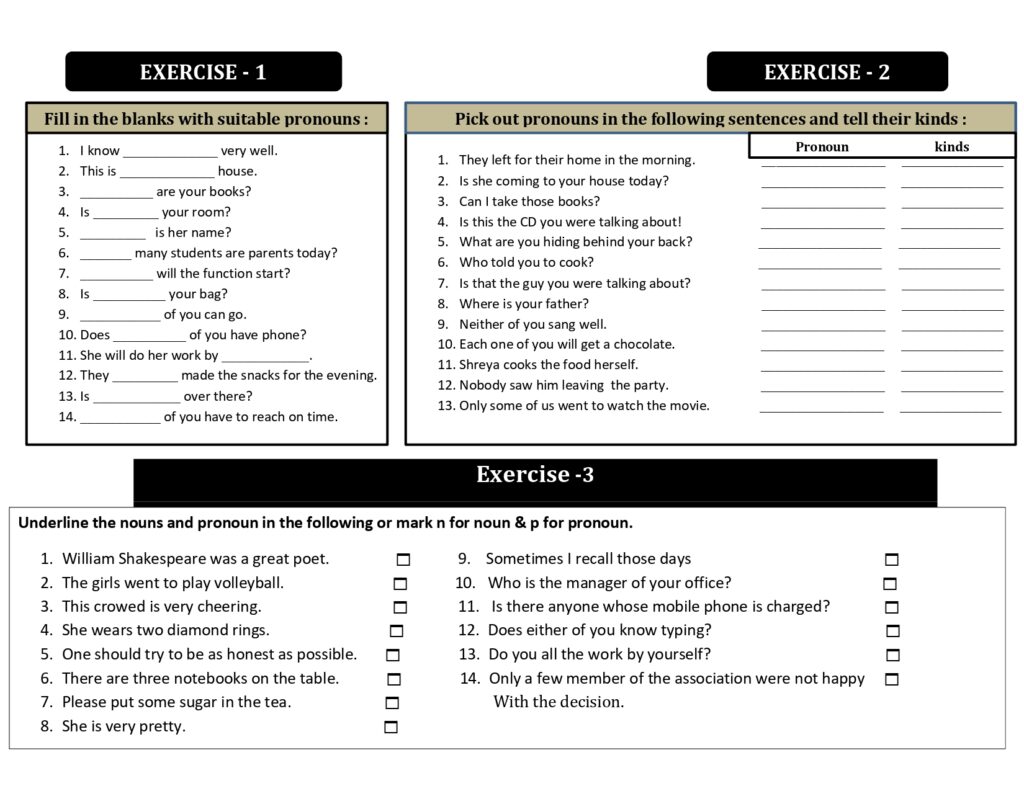- Pronouns are used in place of a noun that has already been mentioned or that is already known, often to avoid repeating the noun.
Example :
Riya hardly eats junk food.
Here Riya is a noun.
She hardly eats junk food.
Here she is pronoun which is used in place of a noun.
KINDS OF PRONOUN :
- There are seven kinds of pronoun.
- Personal pronoun
- Relative pronoun
- Interrogative pronoun
- Indefinite pronoun
- Emphatic pronoun
- Distributive pronoun
- Demonstrative pronoun
- PERSONAL PRONOUN :-
- It is used for a particular person or object. It changes its forms to indicate different genders, case, numbers and people speaking.
Example :
GENDER He, him, his, This is his car. She, her hers, she is shopping.
CASE Possessive case – ( This is my house.)
SUBJECTIVE He is at work.
OBJECTIVE They will meet us today.
NUMBERS SINGULAR PRONOUN – (This car belongs to me.),
PLURAL PRONOUN – ( This is their house.)
- RELATIVE PRONOUN :
- It is used to relate or join two different clauses simultaneously by specifying the noun used in the clause before.
Examples:
She will pick the dress that will look good on her sister.
I am looking for a person who is wearing black.
- INTERROGATIVE PRONOUN :
- What, who, whom, whose, which, why, when are used as interrogative pronoun in order to ask a question.
Example:
What is your name?
Whose car is this?
When did you cook food?
Why are you crying?
Whom do you love?
Which is your book?
Who is your sister?
How will you reach there?
- INDEFINITE PRONOUN :
- Anyone, someone, many, some few, all, one, none, nobody, somebody, some, many, everything and others are used as indefinite pronouns to unspecified or objects, in bot singular or plural form.
Example :
Has anyone reached yet?
Is someone there?
There are many people in the hall.
Some of the boys have left.
There are only few students in the class.
All are doing well.
One girl is not studying.
None of the bags have my clothes in it.
Nobody is eating.
Somebody came to the house in the morning.
There are some sweets in the box.
She has many balloons.
They have everything.
Others will come tomorrow.
- EMPHATIC PRONOUN :
- It is used to put emphasis in a statement.
Myself, herself, himself, itself, ourselves, yourselves, themselves.
I will do this task myself.
She is cleaning the house by herself.
He likes to be by himself in sab situations.
The dog hurt itself while jumping from the stairs.
We will cook the food by ourselves.
Don’t discuss the topics that you yourself are not aware of.
They baked some cakes themselves.
- DISTRIBUTIVE PRONOUN :
- It is used to denote the member of a group but separately and not collectively.
Any, each, neither, either, none.
Example:
Is there any food left?
Each of the dance groups performed well.
Neither of them came here.
Either of these pens works.
None of the students failed this year.
- DEMONSTRATIVE PRONOUN:
- It is used to indicate something or someone.
This, that, these, those, such.
Example:
There are my bays.
This is your lunch.
Those students are very naughty.
That boy in blue shirt is very intelligent.


